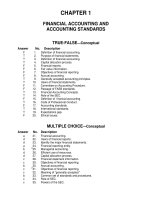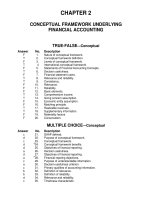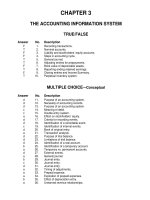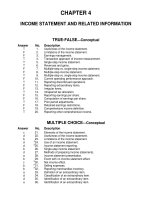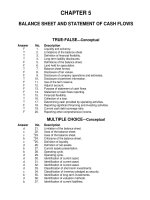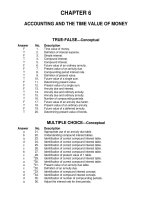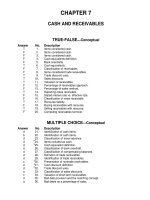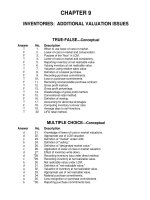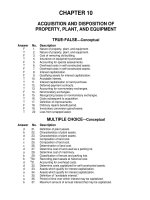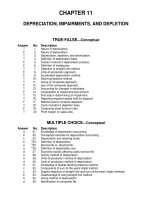Test bank intermediate accounting 14e by kieso chapter 6
Bạn đang xem bản rút gọn của tài liệu. Xem và tải ngay bản đầy đủ của tài liệu tại đây (130.22 KB, 44 trang )
To download more slides, ebook, solutions and test bank, visit
CHAPTER 6
ACCOUNTING AND THE TIME VALUE OF MONEY
IFRS questions are available at the end of this chapter.
TRUE-FALSE—Conceptual
Answer
F
T
F
T
T
F
F
T
T
T
F
F
F
T
T
T
F
T
F
T
No.
Description
1.
2.
3.
4.
5.
6.
7.
8.
9.
10.
11.
12.
13.
14.
15.
16.
17.
18.
19.
20.
Time value of money.
Definition of interest expense.
Simple interest.
Compound interest.
Compound interest.
Future value of an ordinary annuity.
Present value of an annuity due.
Compounding period interest rate.
Definition of present value.
Future value of a single sum.
Determining present value.
Present value of a single sum.
Annuity due and interest.
Annuity due and ordinary annuity.
Annuity due and ordinary annuity.
Number of compounding periods.
Future value of an annuity due factor.
Present value of an ordinary annuity.
Future value of a deferred annuity.
Determining present value of bonds.
MULTIPLE CHOICE—Conceptual
Answer
a
d
b
a
c
d
b
b
a
d
c
c
b
c
c
a
No.
21.
22.
23.
24.
25.
26.
27.
28.
29.
30.
31.
32.
33.
34.
S
35.
S
36.
Description
Appropriate use of an annuity due table.
Time value of money.
Present value situations.
Definition of interest.
Interest variables.
Identification of compounding approach.
Future value factor.
Understanding compound interest tables.
Identification of correct compound interest table.
Identification of correct compound interest table.
Identification of correct compound interest table.
Identification of correct compound interest table.
Identification of correct compound interest table.
Identification of present value of 1 table.
Identification of correct compound interest table.
Identification of correct compound interest table.
To download more slides, ebook, solutions and test bank, visit
Test Bank for Intermediate Accounting, Fourteenth Edition
6-2
MULTIPLE CHOICE—Conceptual (cont.)
Answer
a
c
a
d
d
a
d
c
a
c
b
d
d
b
c
c
b
c
b
b
b
b
c
c
d
P
S
No.
S
37.
38.
P
39.
P
40.
41.
42.
43.
P
44.
45.
46.
47.
48.
49.
50.
P
51.
52.
53.
54.
55.
56.
57.
58.
P
59.
60.
61.
Description
Present value of an annuity due table.
Definition of an annuity due.
Identification of compound interest concept.
Identification of compound interest concept.
Identification of number of compounding periods.
Adjust the interest rate for time periods.
Definition of present value.
Compound interest concepts.
Difference between ordinary annuity and annuity due.
Future value of 1 and present value of 1 relationship.
Identify future value of 1 concept.
Determine best bonus option
Identify future value of an ordinary annuity
Identify future value of an ordinary annuity
Future value of an annuity due factor.
Determine the timing of rents of an annuity due.
Factors of an ordinary annuity and an annuity due.
Determine present value of an ordinary annuity.
Identification of a future value of an ordinary annuity of 1.
Present value of an ordinary annuity and an annuity due.
Difference between an ordinary annuity and an annuity due.
Present value of ordinary annuity and present value of annuity due
relationship
Identify present value of ordinary annuity concept.
Determine least costly option.
Definition of deferred annuities.
These questions also appear in the Problem-Solving Survival Guide.
These questions also appear in the Study Guide.
MULTIPLE CHOICE—Computational
Answer
a
d
d
c
b
a
b
c
c
d
a
d
b
c
c
No.
Description
62.
63.
64.
65.
66.
67.
68.
69.
70.
71.
72.
73.
74.
75.
76.
Calculate the future value of 1.
Calculate amount of interest paid.
Interest compounded quarterly.
Calculate present value of a future amount.
Calculate a future value.
Calculate a future value of an annuity due.
Calculate a future value.
Calculate a future value.
Calculate present value of a future amount.
Calculate present value of a future amount.
Calculate present value of an annuity due.
Calculate the future value of 1.
Present value of a single sum.
Present value of a single sum, unknown number of periods.
Future value of a single sum.
To download more slides, ebook, solutions and test bank, visit
Accounting and the Time Value of Money
6-3
MULTIPLE CHOICE—Computational (cont.)
Answer
b
b
c
d
c
a
c
a
b
c
c
d
d
b
d
d
a
b
c
d
a
b
c
d
a
a
d
c
d
a
b
b
c
a
b
b
b
c
d
a
b
d
b
b
c
b
a
No.
77.
78.
79.
80.
81.
82.
83.
84.
85.
86.
87.
88.
89.
90.
91.
92.
93.
94.
95.
96.
97.
98.
99.
100.
101.
102.
103.
104.
105.
106.
107.
108.
109.
110.
111.
112.
113.
114.
115.
116.
117.
118.
119.
120.
121.
122.
123.
Description
Present value of a single sum.
Present value of a single sum, unknown number of periods.
Future value of a single sum.
Calculate the present value of 1.
Calculate the future value of 1.
Calculate the present value of 1.
Calculate interest rate.
Calculate number of years.
Calculate the future value of 1.
Calculate the present value of 1.
Calculate the present value of 1.
Calculate the present value of 1 and present value of an ordinary annuity.
Calculate number if years.
Calculate the amount of annual deposit.
Calculate the amount of annual deposit.
Calculate the amount of annual deposit.
Present value of an ordinary annuity.
Present value of an annuity due.
Future value of an ordinary annuity.
Future value of a annuity due.
Present value of an ordinary annuity.
Present value of an annuity due.
Future value of an ordinary annuity.
Future value of an annuity due.
Calculate future value of an annuity due.
Calculate future value of an ordinary annuity.
Calculate future value of an annuity due.
Calculate annual deposit for annuity due.
Calculate cost of machine purchased on installment.
Calculate present value of an ordinary annuity.
Calculate present value of an annuity due.
Calculate cost of machine purchased on installment.
Calculate cost of machine purchased on installment.
Calculate the annual rents of leased equipment.
Calculate present value of an investment in equipment.
Calculate proceeds from issuance of bonds.
Calculate proceeds from issuance of bonds.
Calculate present value of an ordinary annuity.
Calculate interest rate.
Calculate present value of an annuity due.
Calculate effective interest rate.
Calculate present value of an ordinary annuity.
Calculate present value of an annuity due.
Calculate annual interest rate.
Calculate interest rate.
Calculate annual lease payment.
Calculate selling price of bonds.
To download more slides, ebook, solutions and test bank, visit
Test Bank for Intermediate Accounting, Fourteenth Edition
6-4
MULTIPLE CHOICE—CPA Adapted
Answer
c
d
c
a
b
a
a
d
b
No.
124.
125.
126.
127.
128.
129.
130.
131.
132.
Description
Calculate interest expense of bonds.
Identification of correct compound interest table.
Calculate interest revenue of a zero-interest-bearing note.
Appropriate use of an ordinary annuity table.
Calculate annual deposit of annuity due.
Calculate the present value of a note.
Calculate the present value of a note.
Determine the issue price of a bond.
Determine the acquisition cost of a franchise.
EXERCISES
Item
E6-133
E6-134
E6-135
E6-136
E6-137
E6-138
E6-139
E6-140
Description
Present and future value concepts.
Compute estimated goodwill.
Present value of an investment in equipment.
Future value of an annuity due.
Present value of an annuity due.
Compute the annual rent.
Calculate the market price of a bond.
Calculate the market price of a bond.
PROBLEMS
Item
P6-141
P6-142
P6-143
P6-144
P6-145
P6-146
Description
Present value and future value computations.
Annuity with change in interest rate.
Present value of ordinary annuity and annuity due.
Finding the implied interest rate.
Calculation of unknown rent and interest.
Deferred annuity.
CHAPTER LEARNING OBJECTIVES
1.
2.
3.
4.
5.
6.
7.
8.
Identify accounting topics where the time value of money is relevant.
Distinguish between simple and compound interest.
Use appropriate compound interest tables.
Identify variables fundamental to solving interest problems.
Solve future and present value of 1 problems.
Solve future value of ordinary and annuity due problems.
Solve present value of ordinary and annuity due problems.
Solve present value problems related to deferred annuities and bonds.
To download more slides, ebook, solutions and test bank, visit
Accounting and the Time Value of Money
6-5
SUMMARY OF LEARNING OBJECTIVES BY QUESTIONS
Item
Type
Item
Type
Item
1.
TF
2.
TF
21.
3.
TF
4.
TF
5.
6.
7.
8.
TF
TF
TF
27.
28.
29.
MC
MC
MC
30.
31.
32.
9.
TF
10.
11.
12.
43.
P
44.
45.
P
P
39.
MC
TF
TF
TF
MC
MC
MC
46.
47.
48.
65.
66.
68.
MC
MC
MC
MC
MC
MC
69.
70.
71.
73.
74.
75.
13.
14.
16.
17.
TF
TF
TF
TF
49.
50.
P
51.
52.
MC
MC
MC
NC
53.
67.
90.
91.
15.
18.
53.
54.
55.
56.
TF
TF
MC
MC
MC
MC
57.
58.
59.
60.
72.
88.
MC
MC
MC
MC
MC
MC
104.
105.
106.
107.
108.
109.
19.
TF
20.
TF
61.
Note:
40.
TF = True-False
MC = Multiple Choice
Type
Item
Type
Item
Learning Objective 1
MC
22. MC
23.
Learning Objective 2
TF
26. MC
62.
Learning Objective 3
S
MC
33. MC
36.
S
MC
34. MC
37.
S
P
MC
35. MC
38.
Learning Objective 4
MC
41. MC
42.
Learning Objective 5
MC
76. MC
82.
MC
77. MC
83.
MC
78. MC
84.
MC
79. MC
85.
MC
80. MC
86.
MC
81. MC
87.
Learning Objective 6
MC
92. MC
96.
MC
93. MC
97.
MC
94. MC
98.
MC
95. MC
99.
Learning Objective 7
MC
110. MC
116.
MC
111. MC
117.
MC
112. MC
118.
MC
113. MC
119.
MC
114. MC
120.
MC
115. MC
121.
Learning Objective 8
MC
123. MC
146.
E = Exercise
P = Problem
Type
Item
Type
MC
24.
MC
MC
63.
MC
MC
MC
64.
125.
MC
MC
MC
MC
MC
MC
MC
MC
88.
89.
124.
126.
133.
134.
MC
MC
MC
MC
MC
MC
MC
MC
MC
MC
Item
Type
25.
MC
124.
MC
MC
MC
MC
MC
E
E
135.
141.
E
P
100.
101.
102.
103.
MC
MC
MC
MC
136.
142.
E
P
122.
127.
128.
137.
138.
139.
MC
MC
MC
E
E
E
140.
141.
143.
144.
145.
E
P
P
P
P
MC
P
To download more slides, ebook, solutions and test bank, visit
6-6
Test Bank for Intermediate Accounting, Fourteenth Edition
TRUE-FALSE—Conceptual
1. The time value of money refers to the fact that a dollar received today is worth less than a
dollar promised at some time in the future.
2. Interest is the excess cash received or repaid over and above the amount lent or borrowed.
3. Simple interest is computed on principal and on any interest earned that has not been
withdrawn.
4. Compound interest, rather than simple interest, must be used to properly evaluate longterm investment proposals.
5. Compound interest uses the accumulated balance at each year end to compute interest in
the succeeding year.
6. The future value of an ordinary annuity table is used when payments are invested at the
beginning of each period.
7. The present value of an annuity due table is used when payments are made at the end of
each period.
8. If the compounding period is less than one year, the annual interest rate must be converted
to the compounding period interest rate by dividing the annual rate by the number of
compounding periods per year.
9. Present value is the value now of a future sum or sums discounted assuming compound
interest.
10. The future value of a single sum is determined by multiplying the future value factor by its
present value.
11. In determining present value, a company moves backward in time using a process of
accumulation.
12. The unknown present value is always a larger amount than the known future value because
dollars received currently are worth more than dollars to be received in the future.
13. The rents that comprise an annuity due earn no interest during the period in which they are
originally deposited.
14. If two annuities have the same number of rents with the same dollar amount, but one is an
annuity due and one is an ordinary annuity, the future value of the annuity due will be
greater than the future value of the ordinary annuity.
15. If two annuities have the same number of rents with the same dollar amount, but one is an
annuity due and one is an ordinary annuity, the present value of the annuity due will be
greater than the present value of the ordinary annuity.
16. The number of compounding periods will always be one less than the number of rents when
computing the future value of an ordinary annuity.
To download more slides, ebook, solutions and test bank, visit
Accounting and the Time Value of Money
6-7
17. The future value of an annuity due factor is found by multiplying the future value of an
ordinary annuity factor by 1 minus the interest rate.
18. The present value of an ordinary annuity is the present value of a series of equal rents
withdrawn at equal intervals.
19. The future value of a deferred annuity is less than the future value of an annuity not
deferred.
20. At the date of issue, bond buyers determine the present value of the bonds’ cash flows
using the market interest rate.
True False Answers—Conceptual
Item
1.
2.
3.
4.
5.
Ans.
F
T
F
T
T
Item
6.
7.
8.
9.
10.
Ans.
F
F
T
T
T
Item
11.
12.
13.
14.
15.
Ans.
F
F
F
T
T
Item
16.
17.
18.
19.
20.
Ans.
T
F
T
F
T
MULTIPLE CHOICE—Conceptual
21.
Which of the following transactions would require the use of the present value of an
annuity due concept in order to calculate the present value of the asset obtained or liability
owed at the date of incurrence?
a. A capital lease is entered into with the initial lease payment due upon the signing of
the lease agreement.
b. A capital lease is entered into with the initial lease payment due one month subsequent to the signing of the lease agreement.
c. A ten-year 8% bond is issued on January 2 with interest payable semiannually on July
1 and January 1 yielding 7%.
d. A ten-year 8% bond is issued on January 2 with interest payable semiannually on July
1 and January 1 yielding 9%.
22.
What best describes the time value of money?
a. The interest rate charged on a loan.
b. Accounts receivable that are determined uncollectible.
c. An investment in a checking account.
d. The relationship between time and money.
23.
Which of the following situations does not base an accounting measure on present
values?
a. Pensions.
b. Prepaid insurance.
c. Leases.
d. Sinking funds.
To download more slides, ebook, solutions and test bank, visit
6-8
Test Bank for Intermediate Accounting, Fourteenth Edition
24.
What is interest?
a. Payment for the use of money.
b. An equity investment.
c. Return on capital.
d. Loan.
25.
What is NOT a variable that is considered in interest computations?
a. Principal.
b. Interest rate.
c. Assets.
d. Time.
26.
If you invest $50,000 to earn 8% interest, which of the following compounding approaches
would return the lowest amount after one year?
a. Daily.
b. Monthly.
c. Quarterly.
d. Annually.
27.
Which factor would be greater — the present value of $1 for 10 periods at 8% per period
or the future value of $1 for 10 periods at 8% per period?
a. Present value of $1 for 10 periods at 8% per period.
b. Future value of $1 for 10 periods at 8% per period.
c. The factors are the same.
d. Need more information.
28.
Which of the following tables would show the smallest value for an interest rate of 5% for
six periods?
a. Future value of 1
b. Present value of 1
c. Future value of an ordinary annuity of 1
d. Present value of an ordinary annuity of 1
29.
Which table would you use to determine how much you would need to have deposited
three years ago at 10% compounded annually in order to have $1,000 today?
a. Future value of 1 or present value of 1
b. Future value of an annuity due of 1
c. Future value of an ordinary annuity of 1
d. Present value of an ordinary annuity of 1
30.
Which table would you use to determine how much must be deposited now in order to
provide for 5 annual withdrawals at the beginning of each year, starting one year hence?
a. Future value of an ordinary annuity of 1
b. Future value of an annuity due of 1
c. Present value of an annuity due of 1
d. None of these
31.
Which table has a factor of 1.00000 for 1 period at every interest rate?
a. Future value of 1
b. Present value of 1
c. Future value of an ordinary annuity of 1
d. Present value of an ordinary annuity of 1
To download more slides, ebook, solutions and test bank, visit
Accounting and the Time Value of Money
6-9
32.
Which table would show the largest factor for an interest rate of 8% for five periods?
a. Future value of an ordinary annuity of 1
b. Present value of an ordinary annuity of 1
c. Future value of an annuity due of 1
d. Present value of an annuity due of 1
33.
Which of the following tables would show the smallest factor for an interest rate of 10% for
six periods?
a. Future value of an ordinary annuity of 1
b. Present value of an ordinary annuity of 1
c. Future value of an annuity due of 1
d. Present value of an annuity due of 1
34.
The figure .94232 is taken from the column marked 2% and the row marked three periods
in a certain interest table. From what interest table is this figure taken?
a. Future value of 1
b. Future value of annuity of 1
c. Present value of 1
d. Present value of annuity of 1
S
Which of the following tables would show the largest value for an interest rate of 10% for 8
periods?
a. Future amount of 1 table.
b. Present value of 1 table.
c. Future amount of an ordinary annuity of 1 table.
d. Present value of an ordinary annuity of 1 table.
S
On June 1, 2012, Pitts Company sold some equipment to Gannon Company. The two
companies entered into an installment sales contract at a rate of 8%. The contract
required 8 equal annual payments with the first payment due on June 1, 2012. What type
of compound interest table is appropriate for this situation?
a. Present value of an annuity due of 1 table.
b. Present value of an ordinary annuity of 1 table.
c. Future amount of an ordinary annuity of 1 table.
d. Future amount of 1 table.
S
Which of the following transactions would best use the present value of an annuity due of
1 table?
a. Fernetti, Inc. rents a truck for 5 years with annual rental payments of $20,000 to be
made at the beginning of each year.
b. Edmiston Co. rents a warehouse for 7 years with annual rental payments of $120,000
to be made at the end of each year.
c. Durant, Inc. borrows $20,000 and has agreed to pay back the principal plus interest in
three years.
d. Babbitt, Inc. wants to deposit a lump sum to accumulate $50,000 for the construction
of a new parking lot in 4 years.
35.
36.
37.
To download more slides, ebook, solutions and test bank, visit
6 - 10
Test Bank for Intermediate Accounting, Fourteenth Edition
P
A series of equal receipts at equal intervals of time when each receipt is received at the
beginning of each time period is called an
a. ordinary annuity.
b. annuity in arrears.
c. annuity due.
d. unearned receipt.
P
In the time diagram below, which concept is being depicted?
38.
39.
0
1
$1
2
$1
3
$1
4
$1
PV
a.
b.
c.
d.
P
Present value of an ordinary annuity
Present value of an annuity due
Future value of an ordinary annuity
Future value of an annuity due
40.
On December 1, 2012, Richards Company sold some machinery to Fleming Company.
The two companies entered into an installment sales contract at a predetermined interest
rate. The contract required four equal annual payments with the first payment due on
December 1, 2012, the date of the sale. What present value concept is appropriate for this
situation?
a. Future amount of an annuity of 1 for four periods
b. Future amount of 1 for four periods
c. Present value of an ordinary annuity of 1 for four periods
d. Present value of an annuity due of 1 for four periods.
41.
An amount is deposited for eight years at 8%. If compounding occurs quarterly, then the
table value is found at
a. 8% for eight periods.
b. 2% for eight periods.
c. 8% for 32 periods.
d. 2% for 32 periods.
42.
If the number of periods is known, the interest rate is determined by
a. dividing the future value by the present value and looking for the quotient in the future
value of 1 table.
b. dividing the future value by the present value and looking for the quotient in the
present value of 1 table.
c. dividing the present value by the future value and looking for the quotient in the future
value of 1 table.
d. multiplying the present value by the future value and looking for the product in the
present value of 1 table.
To download more slides, ebook, solutions and test bank, visit
Accounting and the Time Value of Money
43.
P
6 - 11
Present value is
a. the value now of a future amount.
b. the amount that must be invested now to produce a known future value.
c. always smaller than the future value.
d. all of these.
44.
Which of the following statements is true?
a. The higher the discount rate, the higher the present value.
b. The process of accumulating interest on interest is referred to as discounting.
c. If money is worth 10% compounded annually, $1,100 due one year from today is
equivalent to $1,000 today.
d. If a single sum is due on December 31, 2012, the present value of that sum decreases
as the date draws closer to December 31, 2012.
45.
What is the primary difference between an ordinary annuity and an annuity due?
a. The timing of the periodic payment.
b. The interest rate.
c. Annuity due only relates to present values.
d. Ordinary annuity only relates to present values.
46.
What is the relationship between the future value of one and the present value of one?
a. The present value of one equals the future value of one plus one.
b. The present value of one equals one plus future value factor for n-1 periods.
c. The present value of one equals one divided by the future value of one.
d. The present value of one equals one plus the future value factor for n+1 value
47.
Peter invests $100,000 in a 3-year certificate of deposit earning 3.5% at his local bank.
Which time value concept would be used to determine the maturity value of the
certificate?
a. Present value of one.
b. Future value of one.
c. Present value of an annuity due.
d. Future value of an ordinary annuity.
48.
Jerry recently was offered a position with a major accounting firm. The firm offered Jerry
either a signing bonus of $23,000 payable on the first day of work or a signing bonus of
$26,000 payable after one year of employment. Assuming that the relevant interest rate is
10%, which option should Jerry choose?
a. The options are equivalent.
b. Insufficient information to determine.
c. The signing bonus of $23,000 payable on the first day of work.
d. The signing bonus of $26,000 payable after one year of employment.
49.
If Jethro wanted to save a set amount each month in order to buy a new pick-up truck
when the new models are next available, which time value concept would be used to
determine the monthly payment?
a. Present value of one.
b. Future value of one.
c. Present value of an annuity due.
d. Future value of an ordinary annuity.
To download more slides, ebook, solutions and test bank, visit
6 - 12
50.
P
Test Bank for Intermediate Accounting, Fourteenth Edition
Betty wants to know how much she should begin saving each month to fund her
retirement. What kind of problem is this?
a. Present value of one.
b. Future value of an ordinary annuity.
c. Present value of an ordinary.
d. Future value of one.
51
If the interest rate is 10%, the factor for the future value of annuity due of 1 for n = 5, i =
10% is equal to the factor for the future value of an ordinary annuity of 1 for n = 5, i = 10%
a. plus 1.10.
b. minus 1.10.
c. multiplied by 1.10.
d. divided by 1.10.
52.
Which of the following is true?
a. Rents occur at the beginning of each period of an ordinary annuity.
b. Rents occur at the end of each period of an annuity due.
c. Rents occur at the beginning of each period of an annuity due.
d. None of these.
53.
Which statement is false?
a. The factor for the future value of an annuity due is found by multiplying the ordinary
annuity table value by one plus the interest rate.
b. The factor for the present value of an annuity due is found by multiplying the ordinary
annuity table value by one minus the interest rate.
c. The factor for the future value of an annuity due is found by subtracting 1.00000 from
the ordinary annuity table value for one more period.
d. The factor for the present value of an annuity due is found by adding 1.00000 to the
ordinary annuity table value for one less period.
54.
Al Darby wants to withdraw $20,000 (including principal) from an investment fund at the
end of each year for five years. How should he compute his required initial investment at
the beginning of the first year if the fund earns 10% compounded annually?
a. $20,000 times the future value of a 5-year, 10% ordinary annuity of 1.
b. $20,000 divided by the future value of a 5-year, 10% ordinary annuity of 1.
c. $20,000 times the present value of a 5-year, 10% ordinary annuity of 1.
d. $20,000 divided by the present value of a 5-year, 10% ordinary annuity of 1.
55.
Sue Gray wants to invest a certain sum of money at the end of each year for five years.
The investment will earn 6% compounded annually. At the end of five years, she will need
a total of $40,000 accumulated. How should she compute her required annual investment?
a. $40,000 times the future value of a 5-year, 6% ordinary annuity of 1.
b. $40,000 divided by the future value of a 5-year, 6% ordinary annuity of 1.
c. $40,000 times the present value of a 5-year, 6% ordinary annuity of 1.
d. $40,000 divided by the present value of a 5-year, 6% ordinary annuity of 1.
To download more slides, ebook, solutions and test bank, visit
Accounting and the Time Value of Money
6 - 13
56.
An accountant wishes to find the present value of an annuity of $1 payable at the
beginning of each period at 10% for eight periods. The accountant has only one present
value table which shows the present value of an annuity of $1 payable at the end of each
period. To compute the present value, the accountant would use the present value factor
in the 10% column for
a. seven periods.
b. eight periods and multiply by (1 + .10).
c. eight periods.
d. nine periods and multiply by (1 – .10).
57.
If an annuity due and an ordinary annuity have the same number of equal payments and
the same interest rates, then
a. the present value of the annuity due is less than the present value of the ordinary
annuity.
b. the present value of the annuity due is greater than the present value of the ordinary
annuity.
c. the future value of the annuity due is equal to the future value of the ordinary annuity.
d. the future value of the annuity due is less than the future value of the ordinary annuity.
58.
What is the relationship between the present value factor of an ordinary annuity and the
present value factor of an annuity due for the same interest rate?
a. The ordinary annuity factor is not related to the annuity due factor.
b. The annuity due factor equals one plus the ordinary annuity factor for n−1 periods.
c. The ordinary annuity factor equals one plus the annuity due factor for n+1 periods.
d. The annuity due factor equals the ordinary annuity factor for n+1 periods minus one.
59.
Paula purchased a house for $300,000. After providing a 20% down payment, she
borrowed the balance from the local savings and loan under a 30-year 6% mortgage loan
requiring equal monthly installments at the end of each month. Which time value concept
would be used to determine the monthly payment?
a. Present value of one.
b. Future value of one.
c. Present value of an ordinary annuity.
d. Future value of an ordinary annuity.
60.
Stemway requires a new manufacturing facility. Management found three locations; all of
which would provide needed capacity, the only difference is the price. Location A may be
purchased for $500,000. Location B may be acquired with a down payment of $100,000
and annual payments at the end of each of the next twenty years of $50,000. Location C
requires $40,000 payments at the beginning of each of the next twenty-five years.
Assuming Stemway's borrowing costs are 8% per annum, which option is the least costly
to the company?
a. Location A.
b. Location B.
c. Location C.
d. Location A and Location B.
To download more slides, ebook, solutions and test bank, visit
6 - 14
61.
Test Bank for Intermediate Accounting, Fourteenth Edition
Which of the following is false?
a. The future value of a deferred annuity is the same as the future value of an annuity not
deferred.
b. A deferred annuity is an annuity in which the rents begin after a specified number of periods.
c. To compute the present value of a deferred annuity, we compute the present value of
an ordinary annuity of 1 for the entire period and subtract the present value of the
rents which were not received during the deferral period.
d. If the first rent is received at the end of the sixth period, it means the ordinary annuity
is deferred for six periods.
Multiple Choice Answers—Conceptual
Item
21.
22.
23.
24.
25.
26.
Ans.
a
d
b
a
c
d
Item
27.
28.
29.
30.
31.
32.
Ans.
b
b
a
d
c
c
Item
33.
34.
35.
36.
37.
38.
Ans.
b
c
c
a
a
c
Item
39.
40.
41.
42.
43.
44.
Ans.
a
d
d
a
d
c
Item
45.
46.
47.
48.
49.
50.
Ans.
Item
Ans.
Item
Ans.
a
c
b
d
d
b
51.
52.
53.
54.
55.
56.
c
c
b
c
b
b
57.
58.
59.
60.
61.
b
b
c
c
d
Solution to Multiple Choice question for which the answer is “none of these.”
30. Present value of an Ordinary Annuity of 1.
MULTIPLE CHOICE—Computational
62.
Assume ABC Company deposits $50,000 with First National Bank in an account earning
interest at 6% per annum, compounded semi-annually. How much will ABC have in the
account after five years if interest is reinvested?
a. $67,196.
b. $50,000.
c. $65,000.
d. $66,912.
63.
Charlie Corp. is purchasing new equipment with a cash cost of $150,000 for an assembly
line. The manufacturer has offered to accept $34,440 payment at the end of each of the
next six years. How much interest will Charlie Corp. pay over the term of the loan?
a. $34,440.
b. $150,000.
c. $184,440.
d. $56,640.
64.
If a savings account pays interest at 4% compounded quarterly, then the amount of $1 left
on deposit for 8 years would be found in a table using
a. 8 periods at 4%.
b. 8 periods at 1%.
c. 32 periods at 4%.
d. 32 periods at 1%.
To download more slides, ebook, solutions and test bank, visit
Accounting and the Time Value of Money
6 - 15
Items 65 through 68 apply to the appropriate use of interest tables. Given below are the future
value factors for 1 at 8% for one to five periods. Each of the items 65 to 68 is based on 8%
interest compounded annually.
Periods
1
2
3
4
5
Future Value of 1 at 8%
1.080
1.166
1.260
1.360
1.469
65.
What amount should be deposited in a bank account today to grow to $10,000 three years
from today?
a. $10,000 × 1.260
b. $10,000 × 1.260 × 3
c. $10,000 ÷ 1.260
d. $10,000 ÷ 1.080 × 3
66.
If $3,000 is put in a savings account today, what amount will be available three years from
today?
a. $3,000 ÷ 1.260
b. $3,000 × 1.260
c. $3,000 × 1.080 × 3
d. ($3,000 × 1.080) + ($3,000 × 1.166) + ($3,000 × 1.260)
67.
What amount will be in a bank account three years from now if $6,000 is invested each
year for four years with the first investment to be made today?
a. ($6,000 × 1.260) + ($6,000 × 1.166) + ($6,000 × 1.080) + $6,000
b. $6,000 × 1.360 × 4
c. ($6,000 × 1.080) + ($6,000 × 1.166) + ($6,000 × 1.260) + ($6,000 × 1.360)
d. $6,000 × 1.080 × 4
68.
If $4,000 is put in a savings account today, what amount will be available six years from
now?
a. $4,000 × 1.080 × 6
b. $4,000 × 1.080 × 1.469
c. $4,000 × 1.166 × 3
d. $4,000 × 1.260 × 2
Items 69 through 72 apply to the appropriate use of present value tables. Given below are the
present value factors for $1.00 discounted at 10% for one to five periods. Each of the items 69 to
72 is based on 10% interest compounded annually.
Present Value of $1
Discounted at 10% per Period
Periods
1
0.909
2
0.826
3
0.751
4
0.683
5
0.621
To download more slides, ebook, solutions and test bank, visit
6 - 16
Test Bank for Intermediate Accounting, Fourteenth Edition
69.
If an individual put $4,000 in a savings account today, what amount of cash would be
available two years from today?
a. $4,000 × 0.826
b. $4,000 × 0.826 × 2
c. $4,000 ÷ 0.826
d. $4,000 ÷ 0.909 × 2
70.
What is the present value today of $6,000 to be received six years from today?
a. $6,000 × 0.909 × 6
b. $6,000 × 0.751 × 2
c. $6,000 × 0.621 × 0.909
d. $6,000 × 0.683 × 3
71.
What amount should be deposited in a bank today to grow to $3,000 three years from
today?
a. $3,000 ÷ 0.751
b. $3,000 × 0.909 × 3
c. ($3,000 × 0.909) + ($3,000 × 0.826) + ($3,000 × 0.751)
d. $3,000 × 0.751
72.
What amount should an individual have in a bank account today before withdrawal if
$5,000 is needed each year for four years with the first withdrawal to be made today and
each subsequent withdrawal at one-year intervals? (The balance in the bank account
should be zero after the fourth withdrawal.)
a. $5,000 + ($5,000 × 0.909) + ($5,000 × 0.826) + ($5,000 × 0.751)
b. $5,000 ÷ 0.683 × 4
c. ($5,000 × 0.909) + ($5,000 × 0.826) + ($5,000 × 0.751) + ($5,000 × 0.683)
d. $5,000 ÷ 0.909 × 4
73.
At the end of two years, what will be the balance in a savings account paying 6% annually
if $10,000 is deposited today? The future value of one at 6% for one period is 1.06.
a. $10,000
b. $10,600
c. $11,200
d. $11,236
74.
Mordica Company will receive $250,000 in 7 years. If the appropriate interest rate is 10%,
the present value of the $250,000 receipt is
a. $127,500.
b. $128,290.
c. $377,500.
d. $487,180.
75.
Dunston Company will receive $200,000 in a future year. If the future receipt is discounted
at an interest rate of 10%, its present value is $102,632. In how many years is the
$200,000 received?
a. 5 years
b. 6 years
c. 7 years
d. 8 years
To download more slides, ebook, solutions and test bank, visit
Accounting and the Time Value of Money
6 - 17
76.
Milner Company will invest $400,000 today. The investment will earn 6% for 5 years, with
no funds withdrawn. In 5 years, the amount in the investment fund is
a. $400,000.
b. $520,000.
c. $535,292.
d. $536,116.
77.
Barber Company will receive $800,000 in 7 years. If the appropriate interest rate is 10%,
the present value of the $800,000 receipt is
a. $408,000.
b. $410,528.
c. $1,208,000.
d. $1,558,976.
78.
Barkley Company will receive $300,000 in a future year. If the future receipt is discounted
at an interest rate of 8%, its present value is $189,051. In how many years is the
$300,000 received?
a. 5 years
b. 6 years
c. 7 years
d. 8 years
79.
Altman Company will invest $500,000 today. The investment will earn 6% for 5 years, with
no funds withdrawn. In 5 years, the amount in the investment fund is
a. $500,000.
b. $650,000.
c. $669,115.
d. $670,145.
80.
John Jones won a lottery that will pay him $2,000,000 after twenty years. Assuming an
appropriate interest rate is 5% compounded annually, what is the present value of this
amount?
a. $2,000,000.
b. $5,306,600.
c. $24,924,420.
d. $753,780.
81.
Angie invested $100,000 she received from her grandmother today in a fund that is
expected to earn 10% per annum. To what amount should the investment grow in five
years if interest is compounded semi-annually?
a. $155,134.
b. $161,050.
c. $162,890.
d. $177,156.
82.
Bella requires $120,000 in four years to purchase a new home. What amount must be
invested today in an investment that earns 6% interest, compounded annually?
a. $95,051.
b. $98,724.
c. $145,337.
d. $151,497.
To download more slides, ebook, solutions and test bank, visit
6 - 18
Test Bank for Intermediate Accounting, Fourteenth Edition
83.
What interest rate (the nearest percent) must Charlie earn on a $150,000 investment
today so that he will have $380,000 after 12 years?
a. 6%.
b. 7%.
c. 8%.
d. 9%.
84.
Ethan has $80,000 to invest today at an annual interest rate of 4%. Approximately how
many years will it take before the investment grows to $162,000?
a. 18 years.
b. 20 years.
c. 16 years.
d. 11 years.
85.
Jane wants to set aside funds to take an around the world cruise in four years. Assuming
that Jane has $8,000 to invest today in an account expected to earn 6% per annum, how
much will she have to spend on her vacation?
a. $6,336.
b. $10,100.
c. $34,997.
d. $10,706.
86.
Jane wants to set aside funds to take an around the world cruise in four years. Jane
expects that she will need $10,000 for her dream vacation. If she is able to earn 8% per
annum on an investment, how much will she have to set aside today so that she will have
sufficient funds available?
a. $2,219.
b. $13,604.
c. $7,350.
d. $6,806.
87.
What would you pay for an investment that pays you $3,000,000 after forty years?
Assume that the relevant interest rate for this type of investment is 6%.
a. $93,540.
b. $935,400.
c. $291,660.
d. $311,010.
88.
What would you pay for an investment that pays you $20,000 at the end of each year for
the next ten years and then returns a maturity value of $300,000 after ten years? Assume
that the relevant interest rate for this type of investment is 8%.
a. $138,958.
b. $134,202.
c. $144,936.
d. $273,158.
To download more slides, ebook, solutions and test bank, visit
Accounting and the Time Value of Money
6 - 19
89.
Anna has $30,000 to invest. She requires $50,000 for a down payment for a house. If she
is able to invest at 6%, how many years will it be before she will accumulate the desired
balance?
a. 6 years.
b. 7 years.
c. 8 years.
d. 9 years.
90.
Lucy and Fred want to begin saving for their baby's college education. They estimate that
they will need $200,000 in eighteen years. If they are able to earn 6% per annum, how
much must be deposited at the beginning of each of the next eighteen years to fund the
education?
a. $6,471.
b. $6,105.
c. $11,111.
d. $5,924.
91.
Lucy and Fred want to begin saving for their baby's college education. They estimate that
they will need $300,000 in eighteen years. If they are able to earn 5% per annum, how
much must be deposited at the end of each of the next eighteen years to fund the
education?
a. $11,618.
b. $25,664.
c. $24,823.
d. $10,664.
92.
Jane wants to set aside funds to take an around the world cruise in four years. Jane
expects that she will need $10,000 for her dream vacation. If she is able to earn 8% per
annum on an investment, how much will she need to set aside at the beginning of each
year to accumulate sufficient funds?
a. $2,219.
b. $13,604.
c. $7,350.
d. $2,055.
93.
Pearson Corporation makes an investment today (January 1, 2012). They will receive
$6,000 every December 31st for the next six years (2012 – 2017). If Pearson wants to
earn 12% on the investment, what is the most they should invest on January 1, 2012?
a. $24,668.
b. $27,629.
c. $48,691.
d. $54,534.
94.
Garretson Corporation will receive $8,000 today (January 1, 2012), and also on each
January 1st for the next five years (2013 – 2017). What is the present value of the six
$8,000 receipts, assuming a 12% interest rate?
a. $32,891.
b. $36,838.
c. $64,922.
d. $72,712.
To download more slides, ebook, solutions and test bank, visit
6 - 20
Test Bank for Intermediate Accounting, Fourteenth Edition
95.
Spencer Corporation will invest $15,000 every December 31st for the next six years (2012
– 2017). If Spencer will earn 12% on the investment, what amount will be in the
investment fund on December 31, 2017?
a. $61,671.
b. $69,072.
c. $121,728.
d. $136,335.
96.
Tipson Corporation will invest $15,000 every January 1st for the next six years (2012 –
2017). If Linton will earn 12% on the investment, what amount will be in the investment
fund on December 31, 2017?
a. $61,671
b. $69,072.
c. $121,728.
d. $136,335.
97.
Hiller Corporation makes an investment today (January 1, 2012). They will receive
$40,000 every December 31st for the next six years (2012 – 2017). If Hiller wants to earn
12% on the investment, what is the most they should invest on January 1, 2012?
a. $164,456.
b. $184,191.
c. $324,608.
d. $363,560.
98.
Sonata Corporation will receive $20,000 today (January 1, 2012), and also on each
January 1st for the next five years (2013 – 2017). What is the present value of the six
$40,000 receipts, assuming a 12% interest rate?
a. $164,456.
b. $184,191.
c. $324,608.
d. $363,560.
99.
Renfro Corporation will invest $50,000 every December 31st for the next six years (2012 –
2017). If Renfro will earn 12% on the investment, what amount will be in the investment
fund on December 31, 2017?
a. $205,570
b. $230,240.
c. $405,760.
d. $454,450.
100.
Vannoy Corporation will invest $30,000 every January 1st for the next six years (2012 –
2017). If Wagner will earn 12% on the investment, what amount will be in the investment
fund on December 31, 2017?
a. $123,342.
b. $138,144.
c. $243,456.
d. $272,670.
To download more slides, ebook, solutions and test bank, visit
Accounting and the Time Value of Money
101.
6 - 21
On January 1, 2012, Kline Company decided to begin accumulating a fund for asset
replacement five years later. The company plans to make five annual deposits of $40,000
at 9% each January 1 beginning in 2012. What will be the balance in the fund, within $10,
on January 1, 2017 (one year after the last deposit)? The following 9% interest factors
may be used.
Present Value of
Future Value of
Ordinary Annuity
Ordinary Annuity
4 periods
3.2397
4.5731
5 periods
3.8897
5.9847
6 periods
4.4859
7.5233
a.
b.
c.
d.
$260,932
$239,388
$218,000
$200,000
Use the following 8% interest factors for questions 102 through 105.
7 periods
8 periods
9 periods
Present Value of
Ordinary Annuity
5.2064
5.7466
6.2469
Future Value of
Ordinary Annuity
8.92280
10.63663
12.48756
102.
What will be the balance on September 1, 2018 in a fund which is accumulated by making
$10,000 annual deposits each September 1 beginning in 2011, with the last deposit being
made on September 1, 2018? The fund pays interest at 8% compounded annually.
a. $106,366
b. $89,229
c. $75,600
d. $57,466
103.
If $6,000 is deposited annually starting on January 1, 2012 and it earns 8%, what will the
balance be on December 31, 2019?
a. $53,537
b. $57,820
c. $63,820
d. $68,925
104.
Korman Company wishes to accumulate $400,000 by May 1, 2020 by making 8 equal
annual deposits beginning May 1, 2012 to a fund paying 8% interest compounded
annually. What is the required amount of each deposit?
a. $69,606
b. $37,606
c. $34,820
d. $40,312
To download more slides, ebook, solutions and test bank, visit
6 - 22
Test Bank for Intermediate Accounting, Fourteenth Edition
105.
What amount should be recorded as the cost of a machine purchased December 31,
2012, which is to be financed by making 8 annual payments of $8,000 each beginning
December 31, 2013? The applicable interest rate is 8%.
a. $56,000
b. $49,975
c. $85,093
d. $45,973
106.
How much must be deposited on January 1, 2012 in a savings account paying 6%
annually in order to make annual withdrawals of $25,000 at the end of the years 2012 and
2013? The present value of one at 6% for one period is .9434.
a. $45,835
b. $47,175
c. $50,000
d. $22,250
107.
How much must be invested now to receive $20,000 for 15 years if the first $20,000 is
received today and the rate is 9%?
Present Value of
Ordinary Annuity at 9%
Periods
14
7.78615
15
8.06069
16
8.31256
a. $161,214
b. $175,723
c. $300,000
d. $146,250
108.
Jenks Company financed the purchase of a machine by making payments of $10,000 at
the end of each of five years. The appropriate rate of interest was 8%. The future value of
one for five periods at 8% is 1.46933. The future value of an ordinary annuity for five
periods at 8% is 5.8666. The present value of an ordinary annuity for five periods at 8% is
3.99271. What was the cost of the machine to Jenks?
a. $14,794
b. $39,927
c. $50,000
d. $58,667
109.
A machine is purchased by making payments of $6,000 at the beginning of each of the
next five years. The interest rate was 10%. The future value of an ordinary annuity of 1 for
five periods is 6.10510. The present value of an ordinary annuity of 1 for five periods is
3.79079. What was the cost of the machine?
a. $40,294
b. $36,631
c. $25,019
d. $22,745
To download more slides, ebook, solutions and test bank, visit
Accounting and the Time Value of Money
6 - 23
110.
Lane Co. has a machine that cost $300,000. It is to be leased for 20 years with rent
received at the beginning of each year. Lane wants a return of 10%. Calculate the amount
of the annual rent.
Present Value of
Period
Ordinary Annuity
19
8.36492
20
8.51356
21
8.64869
a. $32,034
b. $35,864
c. $44,592
d. $35,238
111.
Find the present value of an investment in plant and equipment if it is expected to provide
annual earnings of $26,000 for 15 years and to have a resale value of $50,000 at the end
of that period. Assume a 10% rate and earnings at year end. The present value of 1 at
10% for 15 periods is .23939. The present value of an ordinary annuity at 10% for 15
periods is 7.60608. The future value of 1 at 10% for 15 periods is 4.17725.
a. $197,758
b. $209,728
c. $247,758
d. $401,970
112.
On January 2, 2012, Wine Corporation wishes to issue $3,000,000 (par value) of its 8%,
10-year bonds. The bonds pay interest annually on January 1. The current yield rate on
such bonds is 10%. Using the interest factors below, compute the amount that Wine will
realize from the sale (issuance) of the bonds.
Present value of 1 at 8% for 10 periods
Present value of 1 at 10% for 10 periods
Present value of an ordinary annuity at 8% for 10 periods
Present value of an ordinary annuity at 10% for 10 periods
a.
b.
c.
d.
113.
0.4632
0.3855
6.7101
6.1446
$3,000,000
$2,631,204
$3,000,018
$3,318,078
The market price of a $500,000, ten-year, 12% (pays interest semiannually) bond issue
sold to yield an effective rate of 10% is
a. $561,445.
b. $562,311.
c. $566,635.
d. $936,180.
To download more slides, ebook, solutions and test bank, visit
6 - 24
Test Bank for Intermediate Accounting, Fourteenth Edition
114.
John won a lottery that will pay him $150,000 at the end of each of the next twenty years.
Assuming an appropriate interest rate is 8% compounded annually, what is the present
value of this amount?
a. $1,590,540.
b. $32,183.
c. $1,472,723.
d. $6,864,294.
115.
Jonas won a lottery that will pay him $200,000 at the end of each of the next twenty years.
Zebra Finance has offered to purchase the payment stream for $2,718,000. What interest
rate (to the nearest percent) was used to determine the amount of the payment?
a. 7%.
b. 6%.
c. 5%.
d. 4%.
116.
James leases a ski chalet to his best friend, Janet. The lease term is five years with
$16,000 annual payments due at the beginning of each year. What is the present value of
the payments discounted at 8% per annum?
a. $68,994.
b. $63,884.
c. $61,077.
d. $57,990.
117.
Jeremy is in the process of purchasing a car. The list price of the car is $36,000. If Jeremy
pays cash for the car, the dealer will reduce the price by 10%. Otherwise, the dealer will
provide financing where Jeremy must pay $7,706 at the end of each of the next five years.
Compute the effective interest rate to the nearest percent that Jeremy would pay if he
chooses to make the five annual payments?
a. 5%.
b. 6%.
c. 7%.
d. 8%.
118.
What would you pay for an investment that pays you $15,000 at the end of each year for
the next twenty years? Assume that the relevant interest rate for this type of investment is
12%.
a. $125,487.
b. $1,080,786.
c. $15,550.
d. $112,042.
119.
What would you pay for an investment that pays you $20,000 at the beginning of each
year for the next ten years? Assume that the relevant interest rate for this type of
investment is 10%.
a. $122,890.
b. $135,180.
c. $129,902.
d. $142,892.
To download more slides, ebook, solutions and test bank, visit
Accounting and the Time Value of Money
6 - 25
120.
Ziggy is considering purchasing a new car. The cash purchase price for the car is
$33,600. What is the annual interest rate if Ziggy is required to make annual payments of
$7,800 at the end of the next five years?
a. 4%.
b. 5%.
c. 6%.
d. 7%.
121.
Charlie Corp. is purchasing new equipment with a cash cost of $200,000 for the assembly
line. The manufacturer has offered to accept $45,920 payments at the end of each of the
next six years. What is the interest rate that Charlie Corp. will be paying?
a. 8%.
b. 9%.
c. 10%.
d. 11%.
122.
Jeremy Leasing purchases and then leases small aircraft to interested parties. The
company is currently determining the required rental for a small aircraft that cost them
$600,000. If the lease is for twenty years and annual lease payments are required to be
made at the end of each year, what will be the annual rental if Jeremy wants to earn a
return of 10%?
a. $64,070.
b. $70,476.
c. $10,476.
d. $30,314.
123.
Stech Co. is issuing $6.5 million 12% bonds in a private placement on July 1, 2012. Each
$1,000 bond pays interest semi-annually on December 31 and June 30 of each year. The
bonds mature in ten years. At the time of issuance, the market interest rate for similar
types of bonds was 8%. What is the expected selling price of the bonds?
a. $8,266,764.
b. $13,566,992.
c. $8,244,598.
d. $8,310,962.
Multiple Choice Answers—Computational
Item
62.
63.
64.
65.
66.
67.
68.
69.
70.
Ans.
a
d
d
c
b
a
b
c
c
Item
71.
72.
73.
74.
75.
76.
77.
78.
79.
Ans.
d
a
d
b
c
c
b
b
c
Item
80.
81.
82.
83.
84.
85.
86.
87.
88.
Ans.
d
c
a
c
a
b
c
c
d
Item
89.
90.
91.
92.
93.
94.
95.
96.
97.
Ans.
Item
Ans.
Item
Ans.
Item
Ans.
d
b
d
d
a
b
c
d
a
98.
99.
100.
101.
102.
103.
104.
105.
106.
b
c
d
a
a
d
c
d
a
107.
108.
109.
110.
111.
112.
113.
114.
115.
b
b
c
a
b
b
b
c
d
116.
117.
118.
119.
120.
121.
122.
123.
a
b
d
b
b
c
b
a
